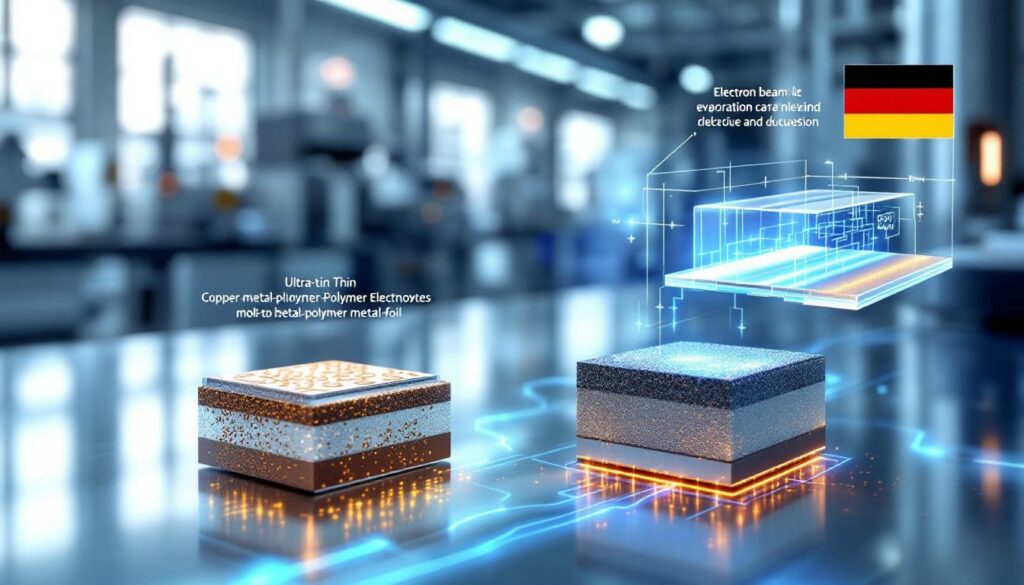The Future of Battery Technology: Fraunhofer FEP Optimises Production Process for Metal-Polymer Electrodes
The battery industry is witnessing a revolutionary advancement with Fraunhofer FEP's innovative metal-polymer electrode technology. This breakthrough approach replaces conventional metal foils with ultra-thin metal coatings on polymer films, promising significant improvements in battery performance, safety, and manufacturability.
Understanding the Metal-Polymer Electrode Technology
Fraunhofer Institute for Electron Beam and Plasma Technology (FEP) has developed a sophisticated roll-to-roll production process that applies precisely controlled metal layers onto polymer substrates. This innovation maintains the electrical conductivity of traditional metal foil current collectors while dramatically reducing their weight.
The technology utilizes electron beam evaporation to deposit approximately 1 micrometer of copper or aluminum onto each side of a 12-micrometer PET film. This ultra-thin coating achieves electrical properties comparable to conventional metal foils that typically measure 8-20 micrometers thick.
"The challenge was to design the polymer films and the coating process so that the thickness of the current collector could be comparable to that of current metal films and the metal layer could have optimum electrical conductivity," explains Claus Luber, Technical Project Manager at Fraunhofer FEP.
The production system operates on industrial-scale equipment capable of processing polymer webs up to 60 centimeters wide, demonstrating the technology's readiness for commercial-scale implementation. The electron beam evaporation process creates uniform, defect-free metal coatings that bond securely to the polymer substrate.
Key Advantages of Metal-Polymer Electrodes
Significant Weight Reduction
The metal-polymer electrode design offers substantial weight advantages over traditional metal foil electrodes:
- Utilizes just 1 micrometer of metal per side versus 8-20 micrometers in conventional foils
- Achieves an estimated 88% reduction in metal usage
- Directly contributes to higher energy density in battery cells
- Enables lighter batteries that can extend range in electric vehicles or operating time in portable devices
For electric vehicle manufacturers, this weight reduction translates to extended driving range or opportunities to reduce overall vehicle weight. In consumer electronics, the technology supports the ever-present demand for longer-lasting, lighter devices.
Enhanced Safety Performance
Perhaps the most critical advantage of the metal-polymer electrodes is their built-in safety mechanism:
- During internal short circuits, the polymer substrate melts at a specific temperature threshold
- This melting action interrupts the current path, preventing continuous heat buildup
- The interruption mechanism stops thermal runaway in its early stages
- This additional safety layer reduces the risk of catastrophic battery failure and fires
This inherent safety feature addresses one of the most persistent concerns with lithium-ion batteries. By physically breaking the circuit during a thermal event, the technology creates a self-limiting failure mode that significantly improves battery safety.
Manufacturing Advantages
The production process offers several manufacturing benefits that position it well for commercial adoption:
- Wrinkle-free production even at industrial scale with 60cm web widths
- Excellent coating adhesion between metal layers and polymer substrate
- Roll-to-roll process compatibility with existing manufacturing equipment
- Straightforward integration potential with current battery production lines
These manufacturing advantages reduce the barriers to adoption for battery producers looking to implement the technology without major production line overhauls. Recent advances in modern manufacturing processes have further improved the efficiency of such production systems.
Technology Validation Through the PolySafe Project
The metal-polymer electrode technology was validated through the PolySafe project, funded by Germany's Federal Ministry of Education and Research (BMBF). This collaborative initiative brought together Fraunhofer FEP's materials expertise with TU Braunschweig's battery research capabilities.
Rigorous Testing Methodology
The research team employed a comprehensive testing approach:
- Manufactured complete pouch cells using the metal-polymer current collectors
- Created conventional reference cells with standard metal foil collectors
- Conducted side-by-side comparisons under identical testing conditions
- Evaluated electrochemical properties, including voltage profiles and internal resistance
- Measured cycle stability through repeated charging and discharging
- Tested rate capability by varying charging and discharging rates
This thorough testing regime provided conclusive evidence of the technology's viability in practical battery applications. The findings complement other innovations in battery recycling breakthrough technologies that are transforming the industry.
Performance Results
The metal-polymer electrodes demonstrated impressive results that validated their commercial potential:
- Achieved comparable electrical conductivity to conventional metal foil current collectors
- Maintained similar cycle stability across different charging and discharging rates
- Demonstrated equivalent overall performance to reference cells using traditional metal foils
- Successfully proved the safety mechanism functions as designed
These results confirm that the metal-polymer technology delivers its weight and safety advantages without compromising on the fundamental performance metrics critical for battery applications.
Technical Challenges Overcome
Developing the metal-polymer electrode technology required solving several complex technical challenges that had previously limited similar approaches.
Material Engineering Solutions
The research team had to overcome multiple material science hurdles:
- Polymer selection: Identifying PET films capable of withstanding the coating process temperatures
- Thermal management: Developing methods to shield the polymer from excessive heat during electron beam evaporation
- Surface preparation: Creating optimal surface conditions for metal adhesion
- Coating uniformity: Ensuring consistent metal thickness across large surface areas
Each of these challenges required innovative solutions that combined materials science expertise with manufacturing process knowledge.
Process Development Breakthroughs
The manufacturing process itself presented significant technical obstacles:
- Precise thickness control: Maintaining consistent ultra-thin metal deposition across large surface areas
- Web handling: Preventing polymer distortion during the high-vacuum coating process
- Surface quality: Ensuring smooth, defect-free coatings suitable for battery applications
- Scale-up considerations: Translating laboratory success to industrial-scale production
The Fraunhofer team's success in addressing these challenges has positioned the technology for commercial implementation. Similar breakthroughs have been seen in the field of direct lithium extraction which is revolutionizing how battery materials are sourced.
Implications for Battery Manufacturing
The metal-polymer electrode technology has far-reaching implications across multiple battery applications and manufacturing considerations.
Industry Applications
This innovation has significant potential across various battery applications:
- Electric vehicles: Lighter batteries could extend range or reduce vehicle weight
- Consumer electronics: Higher energy density for longer-lasting portable devices
- Grid storage: Enhanced safety features for large-scale energy storage systems
- Aerospace applications: Weight-critical systems benefit from lighter battery components
For each application, the technology offers a meaningful advancement in the perpetual quest for batteries that are lighter, safer, and more energy-dense.
Economic Considerations
The metal-polymer electrodes impact battery economics in several positive ways:
- Material cost optimization: Estimated 60-70% reduction in metal usage compared to conventional foils
- Manufacturing efficiency: Roll-to-roll process enables high-volume production
- Safety cost reduction: Decreased risk of thermal runaway could reduce battery management system complexity
- Value chain impact: Potential shift in material supply requirements from metals to specialty polymers
These economic factors could contribute to more cost-effective battery production as the technology scales. Investors in the battery metals investment space are closely watching these developments for new opportunities.
Comparative Analysis Against Other Electrode Innovations
When evaluated against other current collector alternatives, the metal-polymer approach offers a balanced profile of advantages:
| Technology | Weight Reduction | Safety Features | Manufacturing Complexity | Performance |
|---|---|---|---|---|
| Metal-Polymer Electrodes | High | Enhanced thermal protection | Moderate | Comparable to conventional |
| Conventional Metal Foils | None (baseline) | Standard | Low | Baseline reference |
| Carbon-Based Collectors | Very High | Variable | High | Often reduced |
| Nanomaterial Collectors | High | Application-dependent | Very High | Potentially superior |
This comparison highlights the metal-polymer technology's strength as a practical, near-term solution that balances performance enhancements with manufacturing feasibility.
Compatibility with Next-Generation Battery Technologies
The metal-polymer electrodes demonstrate excellent compatibility with emerging battery technologies:
- Solid-state batteries: Enhanced safety features align with solid-state battery goals
- Silicon anodes: Lighter current collectors could offset the weight of silicon-based active materials
- High-nickel cathodes: Improved safety features could mitigate risks associated with high-energy cathode materials
- Lithium-sulfur cells: Weight reduction complements the high theoretical energy density of these systems
This compatibility ensures the technology can contribute to battery advancements beyond just incremental improvements to existing designs. The industry continues to monitor the battery raw materials update closely as these innovations drive changing material needs.
Future Development Roadmap
Commercialization Pathway
The successful demonstration of functional cells positions this technology for further development:
- Scale-up activities: Expanding production to commercial-scale manufacturing
- Industry partnerships: Collaborations with battery manufacturers for implementation
- Regulatory approval: Safety certification and standardization requirements
- Market entry strategy: Initial focus on high-value applications where weight and safety are critical
Industry experts estimate commercial implementation could begin within 1-3 years, depending on partnership development and final optimization work. According to Fraunhofer FEP's energy solutions page, the institute is actively seeking industry partners for technology transfer.
Research Directions
Several promising research avenues could further enhance the technology:
- Alternative polymer substrates: Exploring polyimide and other high-temperature polymers
- Coating optimization: Refining the metal deposition process for even thinner layers
- Integration with active materials: Developing electrode formulations specifically optimized for metal-polymer collectors
- Recycling process development: Creating efficient methods to separate and recover the materials at end-of-life
These research directions will help maximize the technology's impact as it moves toward widespread adoption.
Implementation Considerations for Battery Manufacturers
Battery manufacturers interested in adopting this technology should consider several important factors:
Technical Requirements
The implementation process involves specific technical considerations:
- Equipment needs: Electron beam evaporation capabilities for metal deposition
- Process integration: Modifications to existing electrode manufacturing lines
- Quality control: Inspection methods for metal-polymer current collectors
- Performance validation: Application-specific testing protocols
These technical requirements represent the practical aspects of integrating the new technology into existing production facilities.
Economic Analysis
A comprehensive assessment should include a detailed cost-benefit analysis:
- Capital investment: Equipment costs for metal-polymer electrode production
- Operating expenses: Process energy requirements and maintenance considerations
- Performance benefits: Quantified improvements in energy density and safety
- Lifecycle assessment: Environmental impact comparison with conventional electrodes
This economic analysis will help manufacturers determine the optimal timing and scale for adopting the technology. The TU Braunschweig research article provides additional insights into the safety benefits that could justify the investment.
Frequently Asked Questions About Metal-Polymer Electrode Technology
What types of batteries can benefit from metal-polymer electrodes?
Metal-polymer electrodes are primarily designed for lithium-ion batteries but could potentially benefit various battery chemistries where weight reduction and safety improvements are valuable, including NMC, LFP, and other advanced lithium-based systems. The technology is particularly well-suited for applications where energy density and safety are critical priorities.
Does the technology require significant changes to existing battery production lines?
While some equipment modifications are necessary for the current collector production, the subsequent electrode coating and cell assembly processes remain largely unchanged, facilitating relatively straightforward integration into existing production facilities. The most significant change involves the current collector manufacturing, which would transition from metal foil handling to the roll-to-roll coating process.
How does this technology impact battery recycling?
The polymer component introduces an additional material to separate during recycling, but the reduced metal content could potentially simplify some aspects of the recycling process. Further research is needed to optimize end-of-life management for these electrodes, but preliminary assessments suggest the overall recyclability should remain comparable to conventional batteries.
What is the expected timeline for commercial implementation?
Based on the successful demonstration of functional cells, commercial implementation could begin within 1-3 years, depending on industry adoption rates and further optimization work. Early adopters will likely be manufacturers focused on high-performance applications where the weight and safety benefits offer compelling advantages.
Conclusion
Fraunhofer FEP's metal-polymer electrode technology represents a significant advancement in battery design that addresses multiple industry challenges simultaneously. By replacing conventional metal foils with polymer films coated with ultra-thin metal layers, the technology delivers meaningful improvements in weight reduction and safety while maintaining performance comparable to traditional designs.
The successful validation through the PolySafe project demonstrates the technology's readiness for further development toward commercial implementation. As battery manufacturers seek innovations that can enhance energy density and safety without sacrificing performance or manufacturability, the metal-polymer approach offers a promising path forward.
This technology exemplifies how materials engineering and manufacturing process innovation can unlock new possibilities in battery design, contributing to the ongoing evolution of energy storage systems for applications ranging from electric vehicles to consumer electronics and beyond.
Interested in Investing in the Next Battery Technology Breakthrough?
Stay ahead of market-moving developments in battery technology with Discovery Alert's proprietary Discovery IQ model, delivering real-time alerts on significant ASX mineral discoveries that could power the future of energy storage. Visit our discoveries page to understand how identifying early-stage innovations like metal-polymer electrodes can lead to exceptional investment returns.




